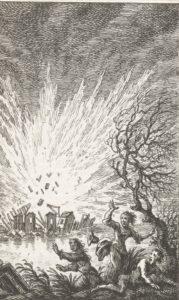 It is that time of year when the leaves begin to turn a beautiful mixture of red and golds, and on the air is filled with the smell of bonfires. This year the BBC have preceded the 5th November with the excellent series ‘Gunpowder’ retelling the story of the plot to blow up the Houses of Parliament. This got me thinking, I have seen lots of remedies for injuries caused by gunpowder but I wondered if gunpowder was ever used in remedies or thought to have medicinal properties.
It is that time of year when the leaves begin to turn a beautiful mixture of red and golds, and on the air is filled with the smell of bonfires. This year the BBC have preceded the 5th November with the excellent series ‘Gunpowder’ retelling the story of the plot to blow up the Houses of Parliament. This got me thinking, I have seen lots of remedies for injuries caused by gunpowder but I wondered if gunpowder was ever used in remedies or thought to have medicinal properties.

It seems that it was not a very common ingredient in remedies. However, Culpeper’s Last Legacy, a medical text trading on the name of Nicholas Culpeper – a popular medical writer – did include a brief suggestion. The author explained that ‘A little Gun-powder tyed up in a rag, and held so in the mouth, that it may touch the aking tooth, instantly easeth the pains of the [t]eeth’.1
The surgical treatise attributed to Paul Barbette included gunpowder in a remedy to help those that had been shot. The text described a series of remedies to draw thorns, thistles and bullets out of the body. One of which was, ‘Quince-wine mingled with Vinegar, and putting some Saffron and Gun-powder amongst it, if you give it to one that hath been shot, it will do him good.’2
While gunpowder might have been a rare medicinal ingredient, one of its component parts saltpeter (the common name for potassium nitrate, now most often used in fertiliser) was found in an array of medicines. The Choice Manual or Rare Secrets in Physick of Elizabeth Grey, Countess of Kent, described how saltpeter boiled in a Goldsmith’s earthen pot, mixed with Roch Alum and Brimstone (or sulphur) made a good medicine for the eyes.3 George Hartman’s collection of remedies mentioned that saltpeter boiled in sack (a type of Spanish wine) was a good solution to soak clothes and apply to sciatica to ease the pain of the condition.4 John Pechey’s Storehouse of Physical Receipts alternatively suggested that ‘Salt-peter’ and ‘white Cristaline Sugar‘ mixed and dissolved in a ‘Draught of Beer‘ was useful to reduce the ‘Effervescence of the Blood and the Heat of the Lungs’.5
Like gunpowder itself, saltpeter was also thought to be beneficial for those who had been burned or shot. The surgical treatise written by Felix Wurtz told readers ‘I will teach you, how the aforesaid Saltpeter is to be prepared for Wounds made with shot’. This involved removing its ‘naughty humidity’. Wurtz explained that saltpeter was known to quench thirst, provoke urine, soothe heat, as well as containing ‘many good qualities’.6 Saltpeter was clearly a versatile and useful medicinal ingredient.
For more Gunpowder posts to enjoy in the run up to bonfire night check out The Many Headed Monster blog – who are explaining the plight of Catholics in England before the plot.
_________
- Culpeper’s Last Legacy (London, 1655), p. 42.
- Paul Barbette, Thesaurus chirurgiae : the chirurgical and anatomical works of Paul Barbette (London, 1687), p. 109.
- Elizabeth Grey Kent, A choice manual of rare and select secrets in physick and chyrurgery (London, 1653), pp. 162-3.
- G. Hartman, The true preserver and restorer of health (London, 1682), p. 214.
- John Pechey, The store-house of physical practice (London, 1695), p. 175.
- Felix Wurtz, An experimental treatise of surgerie (London, 1656), p. 142.


